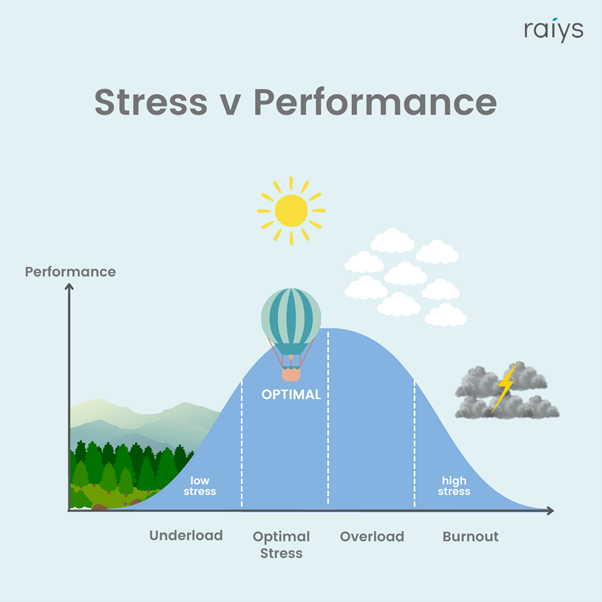Up, Up and Away! It’s Time to Kick the Stress Bucket.
)
The stress bucket has been used as a metaphor since the early 2000s to describe how we can control the build-up of stress in our lives.
It’s the idea of a bucket, with a tap at its base, which fills up with water the more stressed we get to the point where it could overflow and consume us. When we need to relieve the stress, we open the tap and let it out.
While this model has been helpful, with stress consistently cited as one of the most common reasons for someone needing time off work, costing the UK economy £billions, it’s time to consider a more nuanced and ‘uplifting’ approach to stress management.
The Stress Bucket: A Familiar Concept
The stress bucket concept illustrates that we all have a finite capacity for stress and when we reach that capacity, we risk experiencing emotional overflow, even with a release valve.
Yet despite spending countless hours in DIY stores and doing odd jobs around the house, I’m yet to see a bucket with a tap! And who wants a hole in their bucket?
In today’s fast-paced world, stressors vary widely - from work deadlines and family obligations to social pressures and health concerns. Stressors can fluctuate through life stages and our careers.
From the work we do with our clients, it’s clear there’s an increasing desire for performance to be integrated with their stress management strategy.
Limitations of the Stress Bucket Model
- Finite Capacity: The stress bucket suggests a rigid structure and limit on how much stress we can manage. In reality, our capacity for managing stress can fluctuate over time and we are all capable of significant growth.
- Static Representation: The stress bucket is a static image. However, our performance in life is dynamic. Stress comes and goes, as it flows, we can rise and fall.
- Points of Weakness: The release valve, the tap, represents a single point of failure in our stress management strategy. We leave ourselves vulnerable to the valve seizing or the release holes ‘blocking up’ from stress accumulation.
As a child, a bucket meant fun - water fights or sandcastles. Now as an adult? A bucket represents work - washing the car or mopping the floor.
However, a balloon is a very different story.
My hometown of Bristol is famous for the International Balloon Fiesta and those stunning hot air balloons have always made me smile. They rise, they float, they light up the sky.
So, why stick with the limitations of a bucket as our metaphor when we can use the balloon?
The Stress Balloon: A New Metaphor
Picture a balloon representing your stress levels, filling with hot air that causes it to expand and rise into the sky.

This metaphor offers several advantages over the bucket:
- Dynamic Inflation: A balloon can expand as stressors accumulate, representing our ability to adapt to stress without bursting. The hot air symbolises the intensity of our stress, which we can control and lifts us higher, providing a clearer and calmer view of our goals when it reaches the right height.
- Finding the Sweet Spot: A controlled level of stress elevates the balloon, giving us the motivation to tackle our daily challenges and achieve optimal performance. But too much stress can push us into the clouds, where visibility is poor, and we can feel lost. Conversely, too little stress means we lack the hot air needed to lift off the ground, leaving us stagnant and unable to reach our potential.
- Release Mechanism: A hot air balloon is always open to release pressure so there is no mechanism to become stuck. This metaphor emphasises the importance of releasing stress through healthy coping strategies. However, the balloon still risks popping, symbolising the potential consequences of burnout that can affect anyone.
- Grounded Perspective: When we manage our stress effectively, we can keep the ground in view. Instead of soaring high into the clouds, we can maintain a better perspective, making it easier to navigate challenges and find solutions.
The Constant – Focus on Self-care
When we think about the way stress might manifest in the workplace it's important to consider this. Encourage self-care and prevention rather than just focusing on being reactive.
Here are four simple strategies:
- Holistic Approach: Instead of viewing stress as something to contain, consider adopting a more integrated approach that includes physical, mental, and emotional wellbeing. This perspective encourages individuals to engage in proactive self-care rather than merely reacting to stress.
- Community Support: Cultivating strong support networks can significantly reduce feelings of isolation when faced with stress. Open conversations about stress and mental health in personal and professional settings foster a culture of understanding and empathy.
- Time-outs & Boundaries: Short breaks during the workday provide a mental reset. Whether taking a walk, or a brief mindfulness exercise, these time-outs can help manage stress and improve focus. Setting limits on commitments is also essential. By establishing clear boundaries, individuals can prevent overextending themselves and protect their mental health.
- Professional Support: Seeking help from a mental health professional can provide valuable insights and coping strategies. Therapy or counselling can help individuals explore their feelings and develop effective stress management techniques.
Using the stress balloon metaphor helps us think much more clearly about the role stress plays in our lives.
By going up, up and away using our beautiful balloon we can find more effective ways to help people.
Raiys delivers digital and in-person solutions to enhance employee and organisational wellbeing. Find out more at raiys.com










